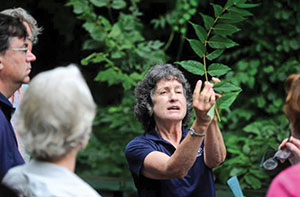A Career in IPM and Invasive Species
 |
|
Donna Ellis leads a guided invasive plant tour in Washington, Connecticut. Source: Donna Ellis |
Donna Ellis, a senior extension educator at the UConn Department of Plant Science and Landscape Architecture, and co-chair of the Connecticut Invasive Plant Working Group (CIPWG), has led an interesting career in IPM and invasive species.
She said her first experiences in growing plants could be attributed to her late father, who had an extensive backyard garden each summer in Delaware and taught her family how to grow vegetables. During summer dinners, he would begin discussion around the table with a question, “Do you know what it takes to grow ____?”, filling in the blank with beans, beets, corn, tomatoes, or whatever else was harvested that day. Pest management was certainly a part of growing produce each season. She learned about common garden pests (and pulled a lot of weeds) during her childhood.
Today, each day brings its share of emails, phone calls, and other inquiries regarding invasive species and related IPM topics; teaching; conducting IPM training programs or site visits for invasive plants; developing, presenting, or participating in meetings, programs, and other events; writing proposals and administering grants. As a state IPM coordinator, she connects regularly with the Northeastern IPM Center.
IPM can be utilized with any type of pest, she noted. Therefore, IPM can play a central role in managing invasive species. One would begin with identifying the problem species, learning about its life cycle and how it affects the desirable plants and the overall habitat. The species would be monitored to determine the extent of the population and damage that is occurring. Management options, if needed, would be considered, and these could include biological, cultural, physical/mechanical, and chemical. One or more types of management may be needed. Most importantly, long-term monitoring should occur to verify and document results of the management undertaken.
One of Ellis’s first responsibilities with invasive species was to conduct exotic pest surveys for the USDA APHIS Cooperative Agricultural Pest Survey (CAPS) Program.
During the mid-1990s at UConn, she had an opportunity to continue her collaboration with USDA APHIS and received funding for invasive species biological control. The first project was releasing Serangium parcesetosum predatory beetles for control of silverleaf whiteflies (Bemisia tabaci) on greenhouse poinsettias.
Additional opportunities to conduct biological control projects for invasive species occurred with USDA APHIS in 2007 for mile-a-minute weed (Persicaria perfoliata) and in 2011 for lily leaf beetle (Lilioceris lilii). The mile-a-minute project is a collaborative effort between UConn and the Connecticut Agricultural Experiment Station. These two projects are still underway, and the biological control agents are establishing at many release sites.
“I remember fondly our first CIPWG organizational meeting attended by thirty people in Vernon, CT where together with the other attendees we listed and ranked our top ten non-native invasive plants. Nineteen years later, CIPWG is still going strong, with 800 email subscribers, an active website, and CIPWG members convening biennial invasive plant symposia attended by an average of 450–500 people.”
The invasive species projects with which she is involved are funded primarily through USDA NIFA, USDA APHIS, and UConn.
She would point newcomers to the IPM website (www.ipm.uconn.edu) and the CIPWG website (cipwg.uconn.edu). Both websites have valuable resources on invasive species and other program areas in IPM.
— by CHRIS GONZALES AND DONNA ELLIS
The Northeastern IPM Center promotes integrated pest management for reducing risks to human health and the environment. If republishing our news, please acknowledge the source (“From Northeast IPM Insights”) along with a link to our website.
